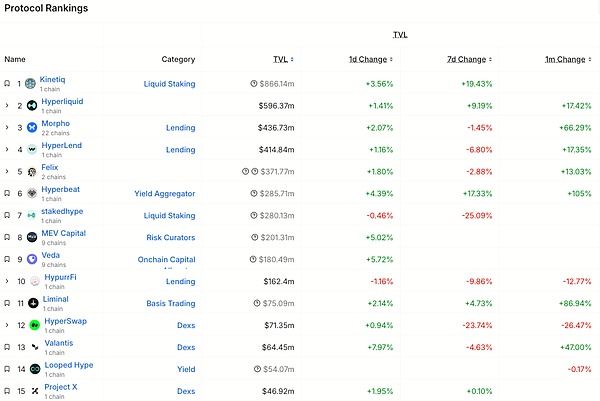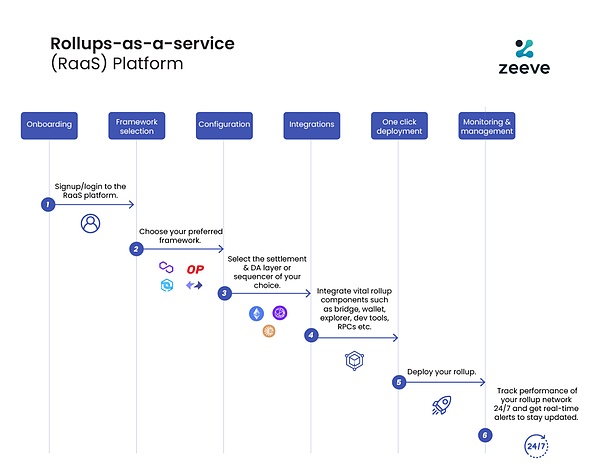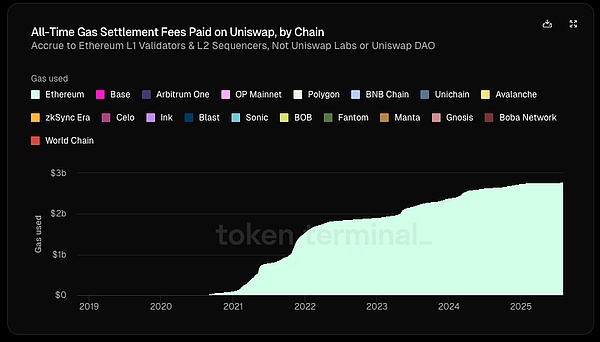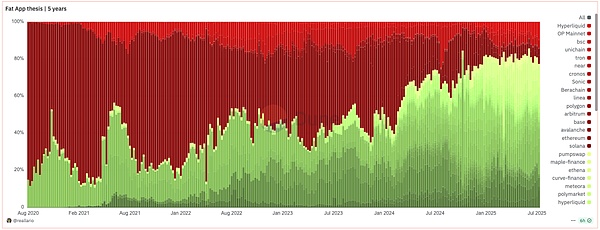Author: Jiawei @IOSG
Three years ago, we wrote an article on Appchain, triggered by dYdX's announcement to migrate its decentralized derivatives protocol from StarkEx L2 to the Cosmos chain, launching its v4 version as an independent blockchain based on the Cosmos SDK and Tendermint consensus.
In 2022, Appchain was a relatively niche technical option. As we move into 2025, with the emergence of more Appchains, particularly the launch of Unichain and HyperEVM, the competitive landscape of the market is quietly changing, forming trends around Appchains. This article will start from this point to discuss our Appchain Thesis.
The Choices of Uniswap and Hyperliquid

▲ Source: Unichain
The concept of Unichain emerged early, with Nascent founder Dan Elitzer publishing "The Inevitability of UNIchain" in 2022, pointing to the necessity of launching Unichain due to Uniswap's scale, brand, liquidity structure, and demand for performance and value capture. Since then, discussions about Unichain have been ongoing.
Unichain officially launched in February, with over 100 applications and infrastructure providers building on it. The current TVL is approximately $1 billion, ranking among the top five of various L2s. In the future, Flashblocks with 200ms block times and the Unichain validation network will be introduced.

▲ Source: DeFiLlama
As a perp, Hyperliquid clearly had a demand for Appchain and deep customization from day one. Beyond its core product, Hyperliquid also launched HyperEVM, which, like HyperCore, is protected by the HyperBFT consensus mechanism.
In other words, in addition to its powerful perp product, Hyperliquid is also exploring the possibility of building an ecosystem. Currently, the HyperEVM ecosystem has over $2 billion in TVL, and ecosystem projects are beginning to emerge.
From the development of Unichain and HyperEVM, we can intuitively see two points:
The competitive landscape of L1/L2 is beginning to differentiate. The combined TVL of Unichain and HyperEVM ecosystems exceeds $3 billion. These assets, in the past, should have been settled in general-purpose L1/L2s like Ethereum and Arbitrum. The emergence of top applications as independent entities has directly led to the loss of core value sources such as TVL, trading volume, transaction fees, and MEV from these platforms.
In the past, L1/L2 and applications like Uniswap and Hyperliquid had a symbiotic relationship, where applications brought activity and users to the platform, and the platform provided security and infrastructure for the applications. Now, Unichain and HyperEVM have become platform layers themselves, forming direct competition with other L1/L2s. They are not only competing for users and liquidity but also for developers, inviting other projects to build on their chains, which significantly changes the competitive landscape.
The expansion paths of Unichain and HyperEVM are distinctly different from current L1/L2s. The latter often build infrastructure first and then attract developers with incentives. In contrast, the model of Unichain and HyperEVM is "product-first"—they first have a market-validated core product with a large user base and brand recognition, and then build ecosystems and network effects around that product.
This path is more efficient and sustainable. They do not need to "buy" ecosystems through high developer incentives but instead "attract" ecosystems through the network effects and technical advantages of their core products. Developers choose to build on HyperEVM because there are high-frequency trading users and real demand scenarios, not because of nebulous incentive promises. Clearly, this is a more organic and sustainable growth model.
What Has Changed in the Past Three Years?

▲ Source: zeeve
First is the maturity of the tech stack and the improvement of third-party service providers. Three years ago, building an Appchain required teams to master full-stack blockchain technology. However, with the development and maturity of RaaS services like OP Stack, Arbitrum Orbit, and AltLayer, developers can now modularly combine various components on demand, greatly reducing the engineering complexity and upfront capital investment required to build an Appchain. The operational model has shifted from building infrastructure in-house to purchasing services, providing flexibility and feasibility for application layer innovation.
Secondly, there is the brand and user mindset. We all know that attention is a scarce resource. Users are often loyal to the brand of the application rather than the underlying technical infrastructure: users use Uniswap because of its product experience, not because it runs on Ethereum. With the widespread adoption of multi-chain wallets and further improvements in UX, users are almost unaware when using different chains—their touchpoints are often first the wallet and the application. When applications build their own chains, users' assets, identities, and usage habits are all embedded within the application ecosystem, forming a strong network effect.

▲ Source: Token Terminal
Most importantly, the pursuit of economic sovereignty by applications is gradually becoming prominent. In the traditional L1/L2 architecture, we can see a clear "top-down" trend in value flow:
The application layer creates value (trading on Uniswap, lending on Aave)
Users pay fees to use the application (application fees + gas fees), with part of these fees going to the protocol and part to LPs or other participants
The gas fees flow 100% to L1 validators or L2 sequencers
MEV is divided among searchers, builders, and validators in varying proportions
Ultimately, L1 tokens capture other value beyond app fees through staking
In this chain, the application layer, which creates the most value, captures the least.
According to Token Terminal statistics, in Uniswap's total value creation of $6.4 billion (including LP earnings, gas fees, etc.), the allocation received by protocols/developers, equity investors, and token holders is less than 1%. Since its launch, Uniswap has generated $2.7 billion in gas revenue for Ethereum, which is about 20% of the settlement fees charged by Ethereum.
So what happens if applications have their own chains?
They can retain gas fees for themselves, using their own tokens as gas tokens; and internalize MEV by controlling sequencers to minimize malicious MEV, returning benign MEV to users; or customize fee models to implement more complex fee structures, etc.
In this light, seeking the internalization of value becomes an ideal choice for applications. When the bargaining power of applications is strong enough, they will naturally demand more economic benefits. Therefore, high-quality applications have a weak dependency on the underlying chain, while the underlying chain has a strong dependency on high-quality applications.
Conclusion

▲ Source: Dune@reallario
The above chart roughly compares the revenue of protocols (in red) and applications (in green) from 2020 to the present. We can clearly see that the value captured by applications is gradually increasing, reaching about 80% this year. This may somewhat overturn Joel Monegro's famous theory of "fat protocols and thin applications."
We are witnessing a paradigm shift from the "fat protocol" theory to the "fat application" theory. Looking back at the pricing logic of projects in the crypto space, it has primarily been driven by "technical breakthroughs" and underlying infrastructure. In the future, it will gradually shift to a pricing method anchored in brand, traffic, and value capture capability. If applications can easily build their own chains based on modular services, the traditional "rent-seeking" model of L1 will be challenged. Just as the rise of SaaS has reduced the bargaining power of traditional software giants, the maturity of modular infrastructure is also weakening the monopoly position of L1.
In the future, the market capitalization of leading applications will undoubtedly exceed that of most L1s. The valuation logic of L1 will shift from "capturing the total value of the ecosystem" to being a stable, secure decentralized "infrastructure service provider," with its valuation logic becoming more akin to that of public goods generating stable cash flow, rather than "monopolistic" giants that can capture most of the ecosystem value. Its valuation bubble will be somewhat squeezed. L1 will also need to rethink its positioning.
Regarding Appchain, our view is that due to its brand, user mindset, and highly customizable on-chain capabilities, Appchain can better solidify long-term user value. In the "fat application" era, these applications can not only capture the direct value they create but also build blockchains around themselves, further externalizing and capturing the value of the infrastructure—they are both products and platforms; they serve end users as well as other developers. In addition to economic sovereignty, top applications will also seek other forms of sovereignty: decision-making power over protocol upgrades, transaction ordering and censorship resistance, and ownership of user data, among others.
Of course, this article primarily discusses the context of top applications like Uniswap and Hyperliquid that have already launched Appchains. The development of Appchain is still in its early stages (Uniswap's TVL on Ethereum still accounts for 71.4%). Protocols like Aave, which involve wrapped assets and collateral and heavily rely on composability on a single chain, are also not well-suited for Appchain. In contrast, perpetual contracts that only require oracles for external demand are more suitable for Appchain. Additionally, Appchain is not the best choice for mid-tier applications; specific situations need to be analyzed on a case-by-case basis. This will not be elaborated further here.
免责声明:本文章仅代表作者个人观点,不代表本平台的立场和观点。本文章仅供信息分享,不构成对任何人的任何投资建议。用户与作者之间的任何争议,与本平台无关。如网页中刊载的文章或图片涉及侵权,请提供相关的权利证明和身份证明发送邮件到support@aicoin.com,本平台相关工作人员将会进行核查。




